In this blog, 15 year old Liv talks about the struggle to keep her teeth straight after orthodontic treatmentSomething done with the aim of improving health or relieving suffering. For example, medicines, surgery, psychological and physical therapies, diet and exercise changes. and looks at new evidence on how well retainers do the job.
Page last updated 23 February 2022
Take-home points
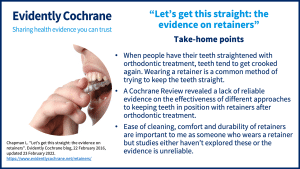
Getting my teeth straightened was a MASSIVE deal. My front teeth were crooked. To the orthodontist, it was a small defect; to me, it was the thing I was most insecure about. It made eating uncomfortable too. When I got them straightened, two years ago now, I felt so different, so confident!
Getting my brace had been a euphoric moment! When the orthodontist said “yes, we can put a brace on those & straighten them out!” it felt like Christmas and I’d just got the present I’d always wanted. Throughout the process, I could see my teeth getting straighter, bit by bit. It was like running a race, getting closer and closer to the finish line, not caring that it hurt, because I was so focused on getting to the end. When the brace came off, it didn’t seem real! I couldn’t stop smiling!
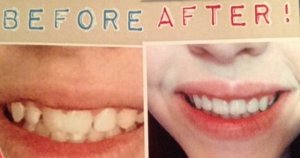
My teeth were straight but would they stay straight?
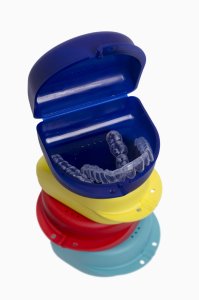
I was made well aware that my teeth might shift back, but I thought it wouldn’t happen to me, if I did all the right things. It was going to be really important to wear a retainer at night and I was determined to wear it every night, come what may.
In the fortnight I was waiting for it to be made, I could feel with my tongue that my teeth didn’t make the perfectly smooth curve I’d felt when I first got the brace off. It was a struggle to make the new retainer fit and I was told to wear it all the time for the next week. After that, I wore it every night, but I had to bite down on it to keep it in place. It got holes in it and eventually snapped. In the time it took to make a new one, my teeth had shifted so much that it didn’t fit at all. Another had to be made. They gave me two this time, so I’d have a spare if one broke.
So, my retainer and I have a love-hate relationship! I like the fact that it’s comfortable in my mouth, soon after I’ve put it in, and that it doesn’t affect my speech. But I HATE how hard it is to clean. I still have to bite down a bit to keep it in place. They’re expensive to replace too.
Different retainer types
I’ve since learned that my type of retainer is a thermoplastic retainer. I just had what I was given, but I knew there were different types as my friends had retainers with a wire (if I’m honest, I was rather looking forward to choosing a pink sparkly one of those!). None of my friends with the wire types seem to have had the problems I’ve had with my retainer. So I was interested to hear that the Cochrane has done a systematic reviewIn systematic reviews we search for and summarize studies that answer a specific research question (e.g. is paracetamol effective and safe for treating back pain?). The studies are identified, assessed, and summarized by using a systematic and predefined approach. They inform recommendations for healthcare and research. of the best evidence on retainers: Retention procedures for stabilising tooth position after treatment with orthodontic braces (published January 2016). Perhaps this could tell us (and our orthodontists) which type of retainer is best, or help people like me decide which might suit them best.
Here’s what I want from a retainer
- It keeps my teeth straight
- It’s easy to clean
- It’s comfortable
- It’s durable
If it’s durable, cost isn’t too big an issue perhaps, but it’s a consideration. Pink and glittery would be an added bonus, of course! Colour aside, is that all too much to ask? Do different types do an equally good job? Better look at the evidence.
How do different retainers compare?
The Cochrane review has evidence from 15 randomizedRandomization is the process of randomly dividing into groups the people taking part in a trial. One group (the intervention group) will be given the intervention being tested (for example a drug, surgery, or exercise) and compared with a group which does not receive the intervention (the control group). controlled trialsA trial in which a group (the ‘intervention group’) is given a intervention being tested (for example a drug, surgery, or exercise) is compared with a group which does not receive the intervention (the ‘control group’). with 1722 adults and children, comparing different types of retainers. The review authors hoped to find out how the retainers compared for teeth stability, retainer failure (breaking, getting holes in them or being lost), unwanted effects on oral health and how satisfied people were with them.
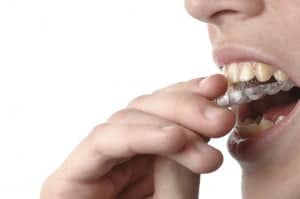
Cochrane reviewsCochrane Reviews are systematic reviews. In systematic reviews we search for and summarize studies that answer a specific research question (e.g. is paracetamol effective and safe for treating back pain?). The studies are identified, assessed, and summarized by using a systematic and predefined approach. They inform recommendations for healthcare and research. always include an assessment of the quality of the evidenceThe certainty (or quality) of evidence is the extent to which we can be confident that what the research tells us about a particular treatment effect is likely to be accurate. Concerns about factors such as bias can reduce the certainty of the evidence. Evidence may be of high certainty; moderate certainty; low certainty or very-low certainty. Cochrane has adopted the GRADE approach (Grading of Recommendations Assessment, Development and Evaluation) for assessing certainty (or quality) of evidence. Find out more here: https://training.cochrane.org/grade-approach and how much the research might have been subject to biasAny factor, recognised or not, that distorts the findings of a study. For example, reporting bias is a type of bias that occurs when researchers, or others (e.g. drug companies) choose not report or publish the results of a study, or do not provide full information about a study.. Most of the studies were assessed as low quality so it’s not clear how the retainers compare. But one studyAn investigation of a healthcare problem. There are different types of studies used to answer research questions, for example randomised controlled trials or observational studies., comparing full-time with part-time wear of thermoplastic retainers, had better (moderate quality) evidence. It suggests that wearing them part time rather than all the time probably makes no difference to teeth stability, but this finding could change when more research is available.
So that’s all this research can tell me about how well they keep teeth straight. How about the other things on my retainer wish list?
- Ease of cleaning: the studies don’t explore this
- Comfort: one study reported that more people were embarrassed by Hawley retainers compared with thermoplastic ones and found them harder to wear, but there isn’t strong evidence to help us choose between retainers
- Durability: again, no reliable evidence
So what difference does this make to choosing our retainers?
Not as much as I would like! Let’s hope that one day I’ll be doing a blog on this with more definitive evidence! Until then, we’ll carry on making a choice based on others’ experiences and/or what our orthodontists offer. The orthodontists working with Cochrane identified this topic as high priority and I know it’s high priority for me and other ex-‘brace faces’! I hope we’ll see more and better research in the next update of this review.
Keep smiling!
Liv Chapman has nothing to disclose.

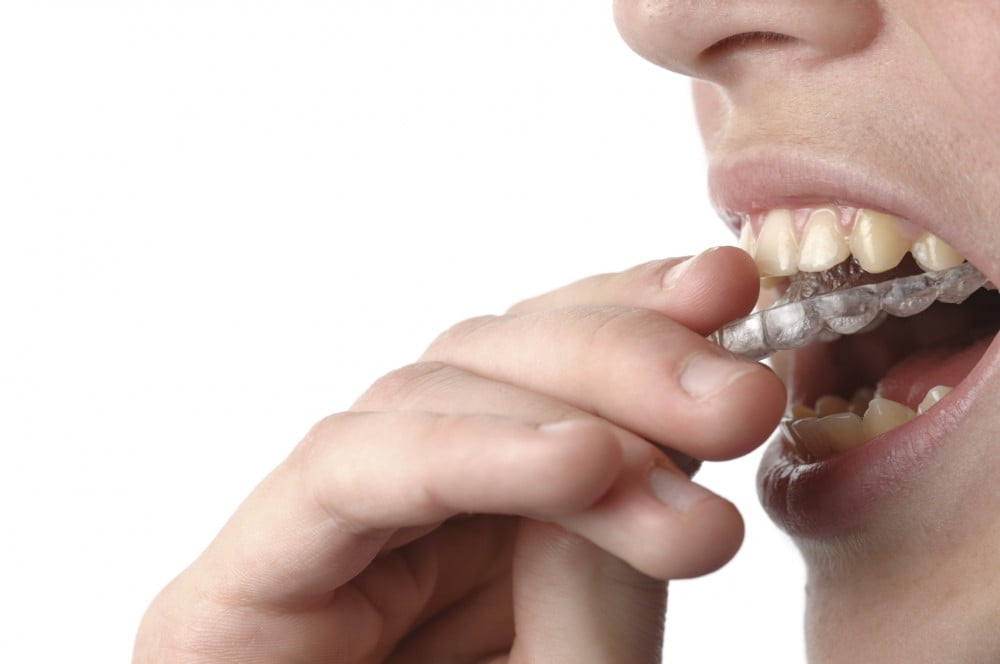

I’m so sorry that your orthadentist did the same thing to you that happened to my cousin. So I’ve worn mine religiously for like 3 months than they told Me to wear it nightly so I’ve realised as soon as I started wearing then nightly only, my teath have slightly changed anyway I plan on getting new ones done just cause mine are starting to wear. My cousin on the other hand is from a poorer city with little health care so even tho she wore hers for 4 years (through her own wedding and compared to my 2 years) she took them off only for them to tell her to straight off the bat only wear them nightly so as it was hurting constantly she just stopped wearing them and it was only till I saw her recently did she realise what had happened. This is so reckless as it is time-consuming, they really need better educated dentists who actually care about their patients. Me and my dentist are so bloodly close I phoned him at 11 at night crying cause I thought I had lost my retainer(back in my newly straightened teeth days) went and got an appointment straight away to get my impressions than end up finding it the next day at work. 😂
I believe this is a column to ask questions about braces …….
I am seeking a second opinion in regards to metal braces. I got mine in September 2016. I’m 51 yr. old now.
The reason for the braces was that I became self-conscious due to overbite and some crocked teeth.
First, my Orthodontist removed 2 teeth (#4) so my front teeth could simply slip back into place. During those 2.5 years I had no issue wearing braces (except my teeth became stained despite the proper dental hygiene).
Recently, my Orthodontist told me that it’s about time to remove braces and get retainer. I would love to getting braces off but don’t want to rush the result. I have tiny spaces/ tears between upper front teeth (definitely due to gums recession ) and I still have small gaps between teeth #3 and #5 (#4 got extracted).
I would like to learn whether wearing retainer will fix those above mentioned or should I wear the braces for a little longer. I have some photos taken and if possible, would like to send it for your reference.
Thank you so much for your response to this matter.
Kind Regards – Monika
I’m afraid we can’t comment on individual cases. I hope you can have some further discussion with your orthodontist to help make your decisions. You could ask him whether there is reliable evidence to help with these choices.
Best wishes,
Sarah (Editor)
btw, by ‘fix retainer’ I mean “permanent retainer”. Not removable one.
Where I live the dentist told me the best is to wear fix retainers (up and bottom) for 5 or more years (even her had one for 5 years), and the ‘plastic’ (removable) retained 1 year for the upper part. I had similar front teeth crooking as you. My braces will be removed in 20 days (after 3 years of wearing them). I think wearing the fix retainers could be much better – they are tiny wires behind the teeth – and they may work better at keeping the teeth in place.